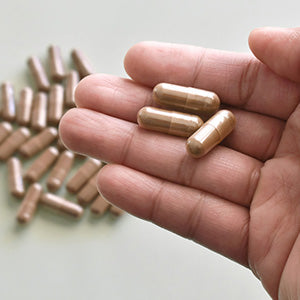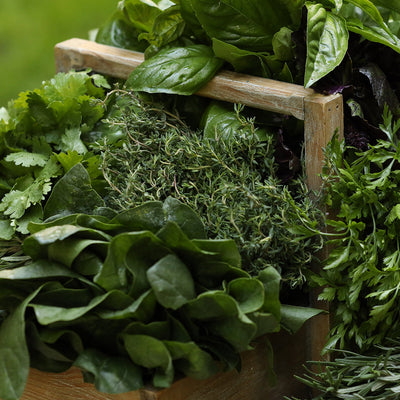Are Microwaves Dangerous to Your Health?

Microwave ovens have been the norm in US households for almost 50 years. If you’re under 40, you’re more likely to have grown up with a microwave than without a microwave. Ever since they were first introduced, microwaves have been a source of controversy. While manufacturers and retailers maintain that microwaves are completely safe, many people still want to know: are microwaves dangerous?
Many of the original concerns about microwave safety, such as radiation leaks and pacemaker malfunctions, have been addressed by modern technology. However, there remain real, potentially serious, health issues that arise from microwave use. Leaks, burns, nutritional concerns, and promoting a culture of laziness and immediate gratification are all good reasons why you may want to consider a different cooking method.
I don’t use a microwave. I don’t have one in my house, and we don’t have one in the break room at Global Healing. First, I’m not a fan of what they produce — food that’s frozen on the inside, and lava-hot on the outside, not to mention bland and soggy. More importantly, I do not believe that microwaves are the safest, or most nutritious, method of cooking food.
Radiation and How Microwaves Work
Let’s talk about radiation. Since microwaves were first available, the biggest concern people have had is the danger of keeping a household appliance designed specifically to create radiation. Microwaves cook food using microwave radiation, generated by a device called a magnetron. Microwave radiation is non-ionizing. Non-ionizing radiation is relatively low energy and is not hazardous when confined to a microwave, especially compared to high-energy ionizing radiation. However, even with a relatively low output, microwave radiation can still cause burns. If you’ve ever cooked meat in a microwave, you’ve seen what unshielded non-ionizing radiation can do to flesh.
Microwaves are shielded specifically to prevent most leaks. However, the key word is “most.” Even at peak efficiency, domestic microwaves do leak some heat. The US Food and Drug Administration allows for some leakage as long as radiation levels fall below what they consider harmful to humans. [1] Microwaves are regulated to ensure only low levels of radiation escape — most of which dissipates within one or two feet.
That may sound good, but low radiation is different from no radiation. The effects of long-term, low-dose, non-ionizing radiation are difficult to observe, and we don’t yet know the full consequences for the human body.
A 2004 study found that small doses of ionizing radiation over the course of years may increase the risk of leukemia.[2] However, this doesn't tell us much about microwaves. That study focused on the effects of ionizing radiation — specifically the type found in medical scanners. Because microwaves produce non-ionizing, electromagnetic radiation, the study isn’t applicable. As of this writing, no long-term studies on the effects of microwave radiation on humans have been completed.
Furthermore, the risk is only minimal if you use a well-maintained appliance according to the manufacturer’s exact instructions. That risk grows considerably if the door, hinges, latch, enclosure, power supply, or seals are damaged. If the shielding is compromised, radiation can leak out. Units with damaged seals, which is especially common in older units, can present a hazard. If your microwave shows signs of damage, send it to the recycling center. Even with an undamaged microwave, dirty door seals can create gaps that allow radiation to escape. Check your seals after every use.[3]
An old concern about microwaves was that the waves they use to cook food could disrupt the function of pacemakers. That’s why microwaves used to have pacemaker warnings on them. Both pacemakers and microwaves these days are shielded well enough to avoid these complications. However, if you have a pacemaker, you should still exercise caution around microwaves. If you feel dizziness or discomfort, get away from the machine immediately and consult your healthcare provider.
Microwave Burns and Superheated Water
Even a brand new microwave carries a small risk of causing burns. Microwaves heat unevenly, and larger portions of foods may not cook all the way through. A food item that seems cool to the touch might scald your mouth when you bite into it.
A lesser-known danger of microwaves is the phenomena of superheated water. When water is heated in a perfectly smooth container, it can actually be heated past the boiling point without actually boiling. Once water is superheated, any slight disturbance, such as picking up the cup, can cause the water to boil all at once, resulting in a violent eruption of scalding water. [1] Impurities make it easier for water to boil, so pure, clean water, like distilled water, is far more likely to experience superheating.
To avoid superheating, never heat water in a microwave for excessive periods of time. Be especially careful with distilled water. A simple way to prevent superheating is to leave a nonmetallic object, like a wooden stir spoon, in the water while you heat it.
How Microwaves Affect Food Quality
While I remain concerned about the burn risks of microwaves, the real health concerns lay in how they affect nutrition.
Microwaves do alter the nutritional content of food; this fact is not in debate. (This is one reason why I advocate for a mostly raw, vegan diet.) The real question is if microwaving food alters its nutritional content differently than other forms of cooking. All cooking changes the chemical structure of food to some degree, but different types of heating alter the nutritional content in different ways. For example, broccoli loses about 74 to 97 percent of its antioxidants when boiled,[4] but retains its nutrients when steamed.
So what nutrients are specifically affected by microwaving? Alliinase, found in garlic, is one. Alliinase is an enzyme with significant benefits for the immune and cardiovascular systems.[5] Unfortunately, it’s sensitive to heat. Forty-five minutes in an oven will render alliinase inert. That’s bad, but there’s a lot you can cook in under 45 minutes. In a microwave, it takes just 60 seconds.[6]
Do you have a breastfeeding infant? Never warm breastmilk in a microwave. Microwaving destroys the essential disease-fighting, baby-protecting agents in breast milk. In one study, breast milk microwaved for just 30 seconds destroyed natural antibodies, paving the way for the growth of potentially harmful bacteria. [7]
There are more examples of compromised nutrition. An Australian study showed that microwaves cause a higher degree of "protein unfolding" than conventional heating.[8] If you have a choice, you want your proteins properly folded. Protein nutrition depends on its structure — when it unfolds, it becomes just a strand of amino acids. You lose the nutritional functionality of the protein. Microwaves are also capable of extensively fragmenting and destroying bacterial DNA, doing so to a far greater degree than heating alone.[9]
Microwaving Food in Plastic and Other Unsafe Containers
Another danger of microwaves comes from the type of cookware you use. If you heat food in a plastic container, some of the chemicals that make up the plastic can leak into your food. Toxic chemicals, like acetyltributylcitrate and dioctyladipate, are common components of plastic food containers. Whenever you heat plastic containers, utensils, or wrap, they release a small portion of these chemicals into your food.[10]
The rate of chemical absorption depends on a number of factors. Temperature, duration of heat, plastic type, and food composition all affect chemical transfer.[10] Old, scratched, or damaged containers are more likely to release harmful particles.[11] Regular use, including cleaning, increases the rate at which the plastic degrades. Heating increases the rate of chemical transfer by 55x.[12] While all methods of heating increase the leach rate, microwaves seem to cause a higher transfer rate than other methods.[10]
Microwaving plastics that aren’t rated microwave-safe is an especially bad idea. Containers made out of polyethylene terephthalate (PET or PETE, or plastic #1), such as most soda bottles, can leach carcinogenic, hormone-disrupting phthalates after repeated use. Commercial-grade cling wrap (commonly found in delis) is made from polyvinyl chloride (PVC, or plastic #3). PVC can release cancer-causing dioxins. Polystyrene (PS, or plastic #6, Styrofoam) is another troublemaker. The base component, styrene, has been associated with skin, eye, and respiratory irritation, depression, fatigue, compromised kidney function, and central nervous system damage.[13]
OK, so you'll only use products labeled as microwave-safe. That should be fine, right? Unfortunately, no. “Microwave safe” is not a particularly strict term. For example, #7 polycarbonate is a durable plastic found in some Tupperware containers and baby bottles. It’s usually labeled as “microwave safe.” The National Institute Of Environmental Health Sciences, however, warns that microwaving causes polycarbonate plastic to break down.[14] Polycarbonate releases hormone-disrupting bisphenol A (BPA), especially when heated.[12]
The Milwaukee Journal Sentinel did an analysis on "microwave safe" products. The study found that products marketed for infants release toxic doses of bisphenol A when heated. In a lab, the containers were heated in a microwave or conventional oven. All of them released toxic amounts of BPA — enough to cause neurological damage in lab animals.[15]
In another study, The Washington Post put hundreds of plastic products through "real world" scenarios, including microwave warming. Results showed that hormone-disrupting chemicals seeped from 95% of the products. Worse, that only accounts for the chemicals we already know are dangerous. As lead scientist Deborah Kurrasch, pointed out, "A lot of the alternative chemicals have not been adequately tested because they don’t have to be... A compound is considered safe (by the FDA) until proven otherwise.”[16]
Prepackaged Meals and Microwave Mentality
One final concern I have with microwaves isn’t the appliance themselves, but the unhealthy habits they encourage. While you can certainly use a microwave to steam broccoli, the fact remains that most microwavable food is terrible for your health. The standard microwavable food is processed and premade. We used to call them TV dinners, but as that term became synonymous with cheap food, they’ve been rebranded as prepackaged meals, ready-made meals, frozen dinners, or microwave meals. Regardless of what you call them, they’re terrible for your health.
To stabilize these products for long term freezer storage, manufacturers add unhealthy ingredients like stabilizers and preservatives. As the freezing process ruins the flavor, these meals tend to be loaded with extra salt, unnamed mystery flavorings, and unhealthy fats. These prepackaged, frozen meals are universally less nutritious than fresh food.
Further, if you grow up using microwaves to cook, it fosters impatience and desire for immediate gratification. Cooking is a labor of love. It takes time, sometimes a great deal of time, to properly prepare nutritious food for yourself and your family. If you grow accustomed to hot food being ready in 2 minutes at the push of a button, then the time and effort it takes to make a healthy meal can seem downright unreasonable.
The truth is that there are better options. Even if you’re too busy to spend all day over a hot stove, there are simple, delicious, nutritious meals that can be prepared in about 10 minutes.
Mitigating Reliance on Microwaves
Over the years, many dangers have been attributed to the microwave oven. Some have proven to be unfounded. That doesn’t necessarily mean that microwaves are the healthiest way to cook. I’m not willing to sacrifice nutrition or taste to save a few minutes on meal prep. Weigh the risks and decide for yourself what’s the best choice for you and your family. If you do choose to keep your microwave, then please follow some basic safety tips.
- Read and follow the manufacturer's instructions.
- Do not stand directly in front of a microwave while in use.
- Do not microwave plastic, especially plastic bags or wrap.
- Make sure that the door seals are clean and free of debris.
- Have all repairs done by a qualified service person only.
- Never use any microwave if the seals are damaged or if the door is damaged in any way, especially if the door won’t close tightly or if the oven continues to operate with an open door.
Whether you’re concerned about burns or simply poor nutrition, there are simple steps you can take to wean yourself off microwaves and unhealthy microwavable food. The risks of poor habits and poor nutrition are far greater than that of radiation, but a minor risk is still a risk. If you are concerned about the effects of long-term, low-dose radiation poisoning, read this article on natural remedies for dealing with radiation exposure.
References (16)
- "Microwave Oven Radiation." U.S. Food and Drug Administration. U.S. Department of Health & Human Services, 8 Oct. 2014. Web. 17 May 2016.
- Leuraud, Klervi, David B. Richardson, Elisabeth Cardis, Robert D. Daniels, Michael Gillies, Jacqueline A. O'hagan, Ghassan B. Hamra, Richard Haylock, Dominique Laurier, Monika Moissonnier, Mary K. Schubauer-Berigan, Isabelle Thierry-Chef, and Ausrele Kesminiene. "Ionising Radiation and Risk of Death from Leukaemia and Lymphoma in Radiation-monitored Workers (INWORKS): An International Cohort Study." The Lancet Haematology 2.7 (2015): n. pag. Thelancet.com. Web. 17 May 2016.
- "OSH Answers Fact Sheets: Microwave Ovens and Their Hazards." Canadian Centre for Occupational Health and Safety. Government of Canada, 1 May 2013. Web. 17 May 2016.
- Vallejo, F., Fa Tomás-Barberán, and C. García-Viguera. "Phenolic Compound Contents in Edible Parts of Broccoli Inflorescences after Domestic Cooking." Journal of the Science of Food and Agriculture J. Sci. Food Agric. 83.14 (2003): 1511-516. Wiley Online Library. Web. 17 May 2016.
- Majewski, M. "Allium Sativum: Facts and Myths regarding Human Health." Rocz Panstw Zakl Hig. 65.1 (2014): 1-8. PubMed. Web. 17 May 2016.
- Song, Kun, and John A. Milner. "The Influence of Heating on the Anticancer Properties of Garlic." The Journal of Nutrition 131.3 (2001): 10545-0575.PubMed. Web. 17 May 2016.
- Quan, Richard, Christine Yang, Steven Rubinstein, Norman J. Lewiston, Philip SunShine, David K. Stevenson, and John A. Kerner, Jr. "Effects of Microwave Radiation on Anti-infective Factors in Human Milk." Pediatrics 89.4 (1992): n. pag. AAP Gateway. Web. 17 May 2016.
- George, Doaa F., Marcela M. Bilek, and David R. Mckenzie. "Non-Thermal Effects in the Microwave Induced Unfolding of Proteins Observed by Chaperone Binding." Bioelectromagnetics 29.4 (2008): 324-30. PubMed. Web. 17 May 2016.
- Kakita, Yukari, Nobuhiro Kashige, Kunihiko Murata, Ataru Kuroiwa, Michiko Funatsu, and Kenji Watanabe. "Inactivation of Lactobacillus Bacteriophage PL-1 by Microwave Irradiation." Microbiology and Immunology 39.8 (1995): 571-76. PubMed. Web. 17 May 2016.
- "Cooking with Plastics." John Hopkins: Bloomberg School of Public Health. John Hopkins University, 3 Dec. 2004. Web. 17 May 2016.
- "Microwaving Food in Plastic: Dangerous or Not?" Harvard Health Publications. Harvard Medical School, 1 Feb. 2006. Web. 17 May 2016.
- Le, Hoa H. et al. "Bisphenol A Is Released from Polycarbonate Drinking Bottles and Mimics the Neurotoxic Actions of Estrogen in Developing Cerebellar Neurons." Toxicology letters 176.2 (2008): 149–156. PMC. Web. 17 May 2016.
- "How Safe Is Tupperware?" Popular Science. Bonnier Corporation, 5 Aug. 2008. Web. 17 May 2016.
- "Bisphenol A (BPA)." National Institute of Environmental Health Sciences. USA.gov, 3 Mar. 2016. Web. 17 May 2016.
- Rust, Susanne, and Meg Kissinger. "BPA Leaches from 'safe' Products." Milwaukee Journal Sentinel. Journal Media Group, 15 Nov. 2008. Web. 17 May 2016.
- Nutt, Amy Ellis. "How to Avoid Products with Toxic Bisphenol-s." The Washington Post. The Washington Post, 13 Jan. 2015. Web. 17 May 2016.
†Results may vary. Information and statements made are for education purposes and are not intended to replace the advice of your doctor. If you have a severe medical condition or health concern, see your physician.

Dr. Edward Group, DC
FOUNDER | HEALER | ADVOCATEDr. Group, DC is a healer and alternative health advocate, and an industry leader and innovator in the field of natural health who is dedicated to helping others. He is a registered doctor of chiropractic (DC), a naturopathic practitioner (NP), and proud alum of Harvard Business School and MIT Sloan School of Management. Dr. Group, DC is the founder of Global Healing – a mission and vision he has shared through best-selling books and frequent media appearances. He aims to spread his message of positivity, hope, and wellness throughout the world.










